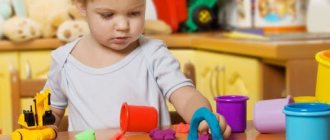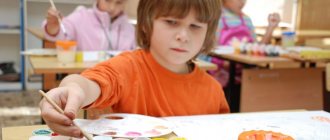Features of the formation of cognitive processes in preschool children
The development of cognitive processes in preschool age occurs in stages. The formation of types, functions, operations of each process of cognition first overcomes the stage of involuntariness.
Younger preschoolers learn about the world involuntarily. They pay attention, perceive and remember only what interests and attracts them.
Since a 3-4 year old child is busy with objective activities, his thinking is also directed only at objects that arouse curiosity.
The main task in the development of cognitive processes is to form the property of arbitrariness. The child must learn to control the functions of cognition and comprehend not only what attracts with its brightness or sonority. The world around us is filled with a variety of objects, phenomena, properties, events, relationships - we have to comprehend them all.
It is possible to get used to and develop in this world only under the condition of purposeful cognition using volitional efforts. This is the arbitrary nature of cognitive processes.
By the time he enters school, along with involuntary perception and attention, it is important for a preschooler to be able to voluntarily use cognitive functions. Elements of voluntariness are laid down on the basis of speech development and such properties as cognitive interest and curiosity.
The structure of the cognitive sphere and a brief description of the development of processes
Cognitive processes form the basis of the cognitive sphere. These include:
- perception;
- imagination;
- memory;
- thinking;
- attention.
They are all so closely intertwined that in the same short period of time they are all involved, instantly switching from one to another.
The last of the listed mental processes has a special function - it acts as a kind of regulator and determines which object will be processed in the brain center. The child pays attention to an object or its detail, to a natural phenomenon or sound, and at the same second he identifies something, remembers it, imagines it, thinks it over.
It stands out for its specific weight in the cognitive sphere and perception. This is the leading cognitive process in preschool age, since mental development begins with the receipt of sensory information through the senses. Gradually, perception acquires meaning and becomes the basis of cognitive activity. From this same process, memory is split off and acquires independent functions of cognition.
Perception
The process of a child's mental development is triggered by perception. Through manipulation of objects and sensory organs, sensory information enters the child's brain. The baby sees colorful figures, touches soft toys, tastes a plastic ring... Consequently, visual and tactile perception are actively involved.
The received sensations are accumulated and stored for further use as sensory standards.
The development of sensation and perception every year leads the preschooler to important achievements:
- identifying the most important signs based on an examination of surrounding objects;
- formation of sensory standards and mastery of their use;
- formation of spatial orientation, concepts of depth, height, etc.;
- perception of time and orientation in time intervals,
- ability to perceive works of art.
By the age of 3, a child already has a certain information base that allows him to recognize, remember, and perceive more complex phenomena and holistic objects.
The youngest preschooler is still examining objects randomly - in the game, the most catchy qualities. But already at the age of 5, a child is able to closely examine a certain object in order to learn as much as possible about it, to identify its features and properties.
In older preschool age, intellectualization of perception occurs. The preschooler sets the task of examining an object or determining its qualities. If necessary, he gives a verbal description of what is perceived with the necessary detail.
Memory
During preschool childhood, a huge amount of information is accumulated and processed. Memory helps to cope with this. A preschooler develops the following types of memory:
- figurative;
- motor;
- verbal.
The first memories are fragmentary, in the form of single ideas about a specific subject. But these discrete representations already allow the child to remember and recognize previously seen objects or familiar people.
Younger preschoolers are focused on the most noticeable signs, and they remember them. More often than not, these signs are not significant. It doesn't matter at all that the ball is red. The main thing is that he is resilient and can jump.
But the ability to analyze at the age of three is still in its infancy, and the child can persistently choose the red ball with which he has already played.
First of all, a preschooler develops figurative memory. While playing with toys or examining an object, he notices more and more characteristics, thanks to which an image is formed. An adult provides significant assistance in the development of a child’s figurative memory if he draws his attention to important signs and pronounces: for example, a teapot has a spout, a flower has petals.
Older preschoolers themselves use speech to better remember information. The figurative type of memory is complemented by the verbal one. Firstly, children learn more and more words, and secondly, they associate a word with an image, moving both one and the other to the corresponding parts of the brain.
The preschooler gradually supplements direct emotional memorization and subsequent recall with voluntary use of memory using verbal form. He learns to subordinate his actions to certain goals. In the same way, he sets himself the task of remembering the story or the order of assembling the construction set in order to reproduce it if necessary.
In older preschool age, voluntary memorization is formed and logical memory is activated, which contributes to the development of other cognitive processes.
Imagination
The mental process of imagination begins to develop at a time when at least a minimal stock of concepts and images accumulates in memory. The simplest use of a small hoop as a steering wheel requires the child to remember the car and have a figurative idea of how to handle this “steering wheel”.
In early preschool age, imagination is only reproductive in nature. The child remembers what he has already seen or heard, shows minimal imagination in order to select suitable substitute objects and use them in play activities.
Children's imagination changes qualitatively if a preschooler learns to supplement a familiar image or plot with new details. At the age of 5, children draw a candy tree and a fairyland, try on the images of wizards and fairies, and come up with role-playing game plots.
A six-year-old child boldly imagines. Can create a fictional character that only vaguely resembles a well-known image. The imagination of an older preschooler is characterized by the fact that he comes up with a plan, and then looks for a means to realize it: draw, sculpt, compose a story. The process of imagination becomes a creative activity.
Thinking
The formation of a preschooler’s thinking occurs through the dominant forms of cognition of reality. The child goes from practical actions to logical conclusions, using forms of thinking:
- clearly effective;
- visually figurative;
- verbal logical.
At the initial stage, the child’s mental activity is closely intertwined with his practical actions. By examining objects, the baby receives information about their properties. By learning to use household appliances, one not only learns their functions, but also receives a lot of additional information. Children draw certain conclusions when they see how the cup breaks, the paper tears, and the towel remains intact no matter how much you pull it.
Elementary actions provide a lot of information that is remembered and used by the child in mental operations. For example, when building a tower of cubes and cones, a child may try to place the cube on the cone, but after the first attempt he will be convinced that such a configuration is impossible and will begin to use the cones only as finishing details.
Visually imaginative thinking allows a preschooler to analyze, compare, and draw conclusions without resorting to action. The child begins to think on the basis of images at the stage when he forms generalized ideas about objects and phenomena.
By accumulating experience in games, creative activities, construction, and speech activities, older children begin to comprehend logic and objective laws. The prerequisites for the development of logical thinking are formed. At first, logical thinking manifests itself as thoughts out loud, often accompanying action. The child learns more and more concepts, expresses his judgments about what he observes or imagines. Verbal logical thinking develops as a transition to theoretical thinking. Gradually, reflections move to the internal plane, and the preschooler formulates a ready-made answer or proposal.
Methods of mental activity are mental operations. By the end of preschool age, analysis, comparison and generalization develop most.
Attention
The development of attention in preschoolers consists of expanding the volume and developing the most important properties:
- distribution;
- sustainability;
- switching
The youngest preschooler already manages to pay attention to two subjects at the same time. Especially if this process is controlled by an adult and offers to examine both objects at the same time (the apple is red-sided, and the pear is yellow; two cubes - large and small). The child needs to distribute his attention, and at first he manages to pay attention to only two objects.
At 3-4 years old, a child is able to do one thing for up to half an hour. But the stability of attention depends on the type of activity. He can look at a picture for no more than 5 minutes, while he can play for 20 minutes. Sustainability of attention increases significantly towards older preschool age and can be seen in activities that are attractive to the child.
The most difficult thing for a preschooler is voluntary switching of attention. Involuntarily, his attention can move from one object to another and linger just as long as interest exists. By the beginning of school, a child needs to learn to switch attention based on a signal. It is important to start such training from the age of 6, since this is a favorable age for the development of this property.
Attention accompanies the formation of all cognitive processes in preschoolers. It functions as a signal to trigger perception, imagination, thinking, and is also a condition that ensures the duration of the process.
In childhood, attention is involuntary, that is, for the most part it occurs unintentionally, based on the interest and cognitive activity of the preschooler. The task of adults is to guide the child, to train him to maintain attention, which will lead to voluntary control of the process.
Neoplasms of early age
The development of active cognitive activity in children of early and early preschool age is marked by the following changes occurring in the structure of the child’s personality.
- Formation and development of self-awareness . The child begins to gradually separate himself from the world around him. He develops such qualities as independence, curiosity, and interest in the world around him. He is interested in everything that happens around him and what surrounds him in particular.
- Basic trust in the world around you . It develops in the process of the child’s interaction with people around him and the acquisition of his first positive experience.
- Determination . The child learns to direct his activities and structure them to achieve his own goals. Children form an understanding of what specific actions need to be performed to obtain a particular result and make their first attempts to follow one or another instruction. Purposefulness gives the child the opportunity to understand the meaning of cognitive activity and complete what he starts. By the beginning of preschool age, this quality must be formed.
- Creative activity . Gaining experience in interacting with the world around him, the child begins to gradually transform it, manipulating and experimenting with its content. Therefore, it is important to encourage his participation in creative activities in any form.
Features of development of young children



